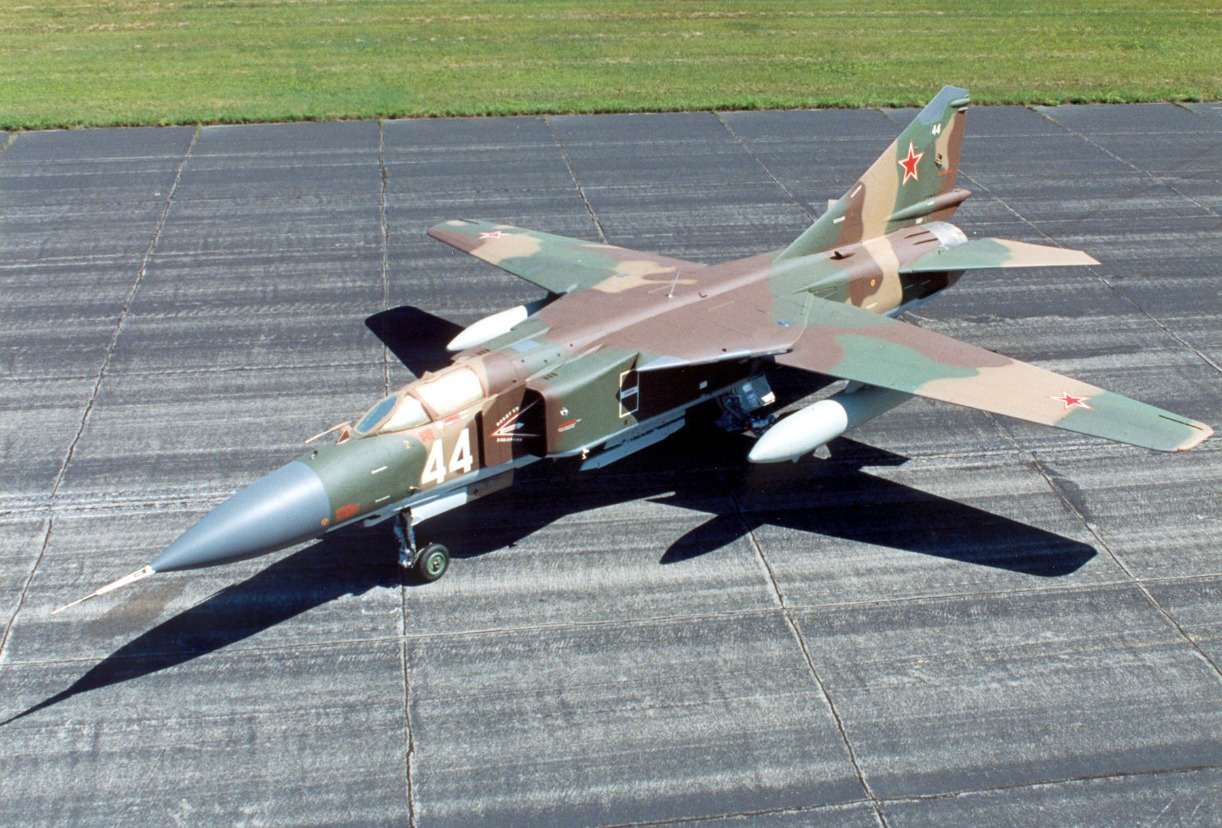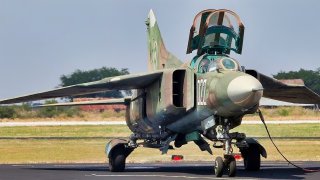The MiG-23 Flogger Was Russia's Big Fighter Jet Failure
The MiG-23 "Flogger" was the Soviet response to the American F-4 Phantom II, developed in the 1960s to replace the aging MiG-21.
Summary and 4 Points You Need to Know: The MiG-23 "Flogger" was the Soviet response to the American F-4 Phantom II, developed in the 1960s to replace the aging MiG-21.
-Featuring a variable-wing sweep design for improved high-speed performance and the versatility to conduct air superiority and ground-attack missions, the MiG-23 was powered by a Tumansky R-27 or R-29 turbojet engine.
-Despite its versatility, the MiG-23 had limitations, including less advanced avionics and reliability issues with its wing mechanism.
-Though widely exported and used in conflicts like the Yom Kippur War and Soviet-Afghan War, it ultimately couldn’t match U.S. systems in terms of sophistication.
The MiG-23, Explained
In the 1960s, the Cold War was heating up. Between the Cuban Missile Crisis at the start of that decade to the U.S. involvement in the Vietnam War in its middle and end, there was an explosion of military developments.
The Americans developed the F-4 Phantom II, a third-generation warplane that was probably one of the greatest warbirds ever made.
The Soviets countered with the Mikoyan Gurevich MiG-23, designated by NATO as “Flogger.”
The Reds needed to replace their aging MiG-21 with a more versatile fighter that could compete with the F-4. The MiG-21 suffered from limited range and poor pilot visibility, and it did not have multi-role capability.
The Specs
One of the most distinctive elements of the Flogger’s design was its variable-wing sweep. This improved performance at any altitude and speed. The design allowed for the MiG-23 to take off and land at lower speeds while maintaining high-speed performance during flight.
A Tumansky R-27 or R-29 turbojet engine powered this warbird. This gave the Flogger substantial thrust, especially when the afterburner kicked in. These planes came fully loaded with an assortment of bombs, rockets, and air-to-air missiles, meaning the MiG-23 could conduct both air superiority and ground attack roles. The radar system for air-to-air combat enhanced the armaments package on this plane beautifully.
One of the downsides of the Flogger was the fact that it did not operate well at low speeds. The MiG-23’s variable-sweep wings meant that it performed better at high speeds as well as high altitudes.
The Soviets used the MiG-23 in a variety of roles for multiple mission sets. It was an all-weather fighter-interceptor, yet Moscow used it – and the MiG-23’s multiple variants – for things like ground-attack, air superiority, and straight-up reconnaissance.

Despite the many mission sets the Flogger could perform, it had many downsides. The MiG-23’s avionics package was considered less advanced than that of its Western rivals. There were complications with the MiG-23’s variable-sweep wing mechanism, reducing the reliability of the warbird.
Understanding the MiG-23 Flogger
The Flogger became a main export system for the Soviets. As such, the MiG-23 saw combat across the world, in service of various militaries that purchased variants of this bird from the Soviets. For example, the MiG-23 served in early engagements during the 1973 Yom Kippur War, being used by the Egyptian Air Force in direct engagements against the U.S.-provided F-4 Phantom IIs and A-4 Skyhawks.
It was a worthy adversary, but the MiG-23’s technology could not counter American systems.
MiG-23 Floggers were used all throughout the failed Soviet-Afghan War of the 1980s. Their operations ranged from reconnaissance to bombardment missions, highlighting the MiG-23’s versatility.
While the MiG-23 held its own against rival U.S. systems, it simply did not balance well against the Americans. It was your typical Russian engineering effort: good enough to challenge local parties, but not sophisticated enough to keep the Americans at bay.
Author Experience and Expertise: Brandon J. Weichert
Brandon J. Weichert, a National Interest national security analyst, is a former Congressional staffer and geopolitical analyst who is a contributor at The Washington Times, the Asia Times, and The-Pipeline. He is the author of Winning Space: How America Remains a Superpower, Biohacked: China’s Race to Control Life, and The Shadow War: Iran’s Quest for Supremacy. His next book, A Disaster of Our Own Making: How the West Lost Ukraine, is due October 22 from Encounter Books. Weichert can be followed via Twitter @WeTheBrandon.
All images are Creative Commons or Shutterstock.
From the Vault
Russia Freaked Out: Why the U.S. Navy 'Unretired' the Iowa-Class Battleships
Battleship vs. Battlecruiser: Iowa-Class vs. Russia's Kirov-Class (Who Wins?)


